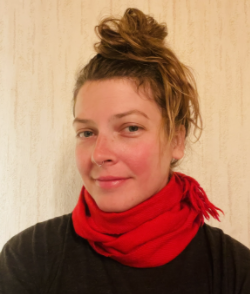All NCLEX Resources
Example Questions
Example Question #1 : Homeopathic And Alternative Medicine
Example Question #2 : General Care
Example Question #2 : Homeopathic And Alternative Medicine
Example Question #52 : Procedures And Care
Which of the following herbs aids in wound healing when applied topically?
Calendula flower (calendula officinalis)
Red raspberry leaf (rubus idaeus)
Yellow dock (rumex crispus)
Hawthorne berry (crataegus ssp)
Calendula flower (calendula officinalis)
Calendula flower contains faradiol and the faradiol monoester, powerful anti-inflammatory and antiedematous triterpenoids, which have shown effects comparable to indomethacin. Yellow dock is as a laxative. Red raspberry leaf is a vasodilator, and may exacerbate inflammation. Hawthorne berry can be used to ameliorate symptoms of congestive heart failure.
Example Question #721 : Nclex
Which of the following herbs contains a compound similar to lovastatin?
Lavender (lavandula)
Red yeast rice (monascus purpureus)
Kava (piper methysticum)
Nettle (urtica dioica)
Red yeast rice (monascus purpureus)
Red yeast rice contains monacolins, which block the production of cholesterol. Monacolin K has the same structure as lovastatin and functions similarly to reduce cholesterol. Nettle is best used as a painkiller, and to treat disorders of the excretory system. Kava is a sedative and anesthetic, and may also be used to treat social anxiety. Lavender has a calming effect, and is effective in inducing sleep.
Example Question #1 : Care
Which is the most common homeopathic remedy for mild otitis media in a child that is weepy, clingy, and refuses fluids?
Belladonna
Pulsatilla
Sepia
Arsenicum album
Pulsatilla
Pulsatilla is most often given for otitis media when the child is clingy, weepy, refuses fluids, and wants to be held or carried. They may be hot or sensitive to heat and desire fresh air. Belladonna may be used as a pain reliever, and and anti-inflammatory remedy. Arsenicum album is commonly used to treat anxiety and gastrointestinal inflammation. Sepia is most often used to treat female reproductive-related ailments.
Example Question #11 : Care
Which of the following hydrotherapy treatment might be most beneficial for a repetitive stress injury?
Hot fomentation
Infrared sauna
Hot and cold contrast therapy
Warming socks
Hot and cold contrast therapy
Hot and cold contrast therapy consists of submerging the painful joint in hot water for 5-10 minutes, then submerging it in cold or icy water for 30 seconds, then back to hot for three cycles. This treatment reduces pain and inflammation and is common in sports medicine. Infrared saunas use radiation to heat the sauna, rather than typical saunas, which primarily use convection. Both are effective for pain relief and relaxation. Hot fomentation can be used to decrease swelling and provide relief from pain due to menstrual cramps. Warming socks are used as a hydrotherapy treatment to increase circulation and raise body temperature, which can help when fighting infection.
Example Question #11 : Care
Which of the following homeopathic remedy is indicated for acute urinary tract infection with intense dysuria and frank hematuria?
Bryonia
Medorrhinum
Cantharis
Calcarea carbonica
Cantharis
Cantharis is indicated in urinary tract infections with frequency, dysuria, and frank hematuria. Patients may also experience flank or back pain, restlessness, and anxiety. Bryonia is used for pains associated with cold and flu. Medorrhinum has been used to treat urethral discharge in male patients with gonorrhea. Calcarea carbonica can be used to treat physical fatigue and muscle atrophy due to malnutrition and/or infections such as mononucleosis.
Example Question #1 : Homeopathic And Alternative Medicine
Which of the following homeopathic remedy is most commonly indicated for post-streptococcal glomerulonephritis?
Palladium
Natrum sulphuricum
Apis
Berberine
Apis
Apis is the most common remedy given for post-streptococcal glomerulonephritis. The patient may be restless and heat intolerant. Other common symptoms are back pain worse in the area of the left kidney and pain or pressure on stooping. Berberine may be used for heart failure, skin burns, and some bacterial infections. Natrum sulphuricum is used to treat liver and gastrointestinal problems. Also, it may be used for headaches, and asthma. Palladium may be used for headaches too.
Example Question #723 : Nclex
Which of the following herbs has hypnotic (sleep-inducing) properties?
Licorice (glycyrrhiza glabra)
Goldenseal (hydrastis canadensis)
Chicory (cichorium intybus)
Passion flower (passiflora incarnata)
Passion flower (passiflora incarnata)
Passion flower has been studied widely for its uses as a sleep aid. It is also anxiolytic, and has been used to treat abdominal pain and GI upset, arrhythmia and hypertension, and topically for burns and hemorrhoids. Note: passion flower is not safe in pregnancy as it may stimulate uterine contractions. Chicory can be used for its toxicity to internal parasites, namely intestinal worms. Goldenseal may be used as a remedy for the common cold and/or upper respiratory infections. Licorice may be used to treat inflammation of the gastrointestinal tract.
All NCLEX Resources




